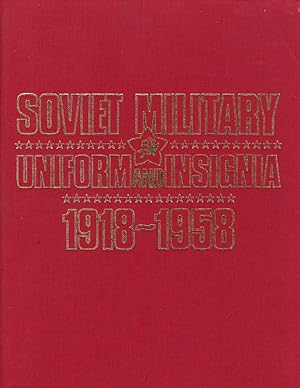alga fund st petersburg russia (2 résultats)
Type d'article
- Tous les types d'articles
- Livres (2)
- Magazines & Périodiques
- Bandes dessinées
- Partitions de musique
- Art, Affiches et Gravures
- Photographies
- Cartes
-
Manuscrits &
Papiers anciens
Etat
- Tous
- Neuf
- Ancien ou d'occasion
Reliure
- Toutes
- Couverture rigide
- Couverture souple
Particularités
- Edition originale (1)
- Signé
- Jaquette
- Avec images (1)
- Sans impression à la demande
Pays
Evaluation du vendeur
-
Soviet Military Uniform and Insignia 1918-1958
Edité par Alga-Fund, St. Petersburg, Russia, 1993
ISBN 10 : 5872900171ISBN 13 : 9785872900177
Vendeur : Clausen Books, RMABA, Colorado Springs, CO, Etats-Unis
Livre
Red Cloth. Etat : Near Fine. Tariel V. Bryanchukov design by (illustrateur). Textblock is very clean and very tight. All page edges are crisp and sound. Minor shelf scuffing to the covers. Lacks dust jacket; 179p. Size: 4to - Over 9 ¾" -12" Tall. Hardcover.
-
Soviet Military Uniform and Insignia 1918-1958
Edité par Alga-Fund, St. Petersburg, Russia, 1993
ISBN 10 : 5872900171ISBN 13 : 9785872900177
Vendeur : Ground Zero Books, Ltd., Silver Spring, MD, Etats-Unis
Livre Edition originale
Hardcover. Etat : Very good. Format is approximately 8.75 inches by 11.75 inches. 116, [2]m 179, [2] pages. Footnotes. Illustrations (most in color). Red binding with decorative titling on front and gold lettering on spine. Minor cover wear and soiling. Minor corner bumping. Contents include Preface to English Edition; Introduction; I. Clothing and Insignia. 1918--May 1924; II. Clothing and Insignia. May 1924 --December 1935; III. Clothing and Insignia. December 19--January 1943; IC. Clothing and Insignia. January 1943--March 1958; Appendices: 1. Colouring of Cloth Tab Backgrounds, Edgings, & Codes of Clothing Articles; 2. Emblems & Codes of Units, Forces, Installations & Educational Institutions; 3. Basic Type Troop command Duties and Their Insignia; 4. Colouring of Visor Caps for cavalry and Horse Drawn Artillery; 5. Command Personnel Insignia; 6. Emblems for Collar Tabs; 7. Insignia of Rank: Medium and Senior Command and Political Personnel; 8. Coloring of Tabs and Edgings on Clothing; 9. Chronological Table of Major Changes in General Army Clothing in 1918-1958; and 10. Illustrative Tables/Figures of Clothing Articles. The Uniforms of the Russian Armed Forces refers to the extensive system of military uniforms, as inherited from the Soviet Armed Forces and modified across the years. Traditionally, the uniforms of the Russian Armed Forces have been subdivided into parade, service dress, and field uniform roles, each with summer and winter variations, largely based on rank, season, and gender differences. Uniforms tend be most distinguishable by branch of service, largely due to colour differences. Other noteworthy subdivisions are based on rank, season, gender, and role. Independent troops use the uniforms from one of these three services with varying modifications, with the Strategic Rocket Forces using Army uniforms and the Airborne Forces using Aerospace Forces uniforms. In terms of division by rank, major distinctions tend to emerge between generals, officers, and enlisted personnel. It is worth noting that warrant officers are categorized with other officers rather than enlisted personnel with regards to uniforms. Variations of uniforms by rank have changed throughout history. There are a number of distinctive uniform designs today that were used in both the Soviet Union and the Russian Empire. For example, belts, aiguillettes, and shoulder straps of ceremonial detachments and honour guard units in solemn occasions, such as parades, state and military holidays, meetings of heads of state, meeting of government delegations, usage in solemn ceremonies, and usage in military honours ceremonies tend to reflect previous periods. The five-pointed star became a Russian military symbol as a result of its importation from socialist heraldry during the Red Army period. The black and orange ovals are directly an importation of the Russian Empire's cockade. The rays are from the Soviet cockade, however, were occasionally part of Imperial uniforms. Presumed First English Language Edition, First printing.



